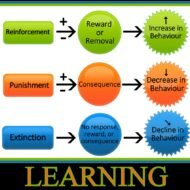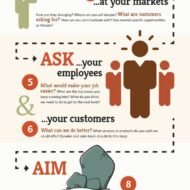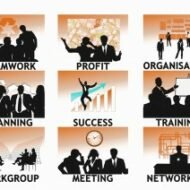Posted by Managementguru in Business Management, Organisational behaviour, Principles of Management
on Mar 7th, 2014 | 0 comments

Reinforcers and Behaviour Changes Reinforcers induce and enhance the association between the cue and the expectancy. This leads to increased performance levels and positive attitude development. This is an effective and efficient strategy that has been proved to be successful. Reinforcement is inevitable for learning process and in a dynamic corporate business environment, unlearning the old things and learning and adapting oneself to satisfy the needs of the changing environmental and economic factors is the critical success factor that serves as the backbone of the success of the company. Significance of Learning: Learning is not the only attribute that gets enhanced by reinforcers; as a result there is a repetition of desirable behavior that helps in maintaining the consistency, cordiality and climate of the organization. Reinforces increase the strength of response leading to desirable or undesirable consequences depending upon the kind of reinforcer, which might be a reward or a punishment. Either way it elicits response that gets strengthened in course of time. Mindset of People: The management side that is the deciding authority has to come to clear terms with the kind of treatment applicable on specific situations; say for instance when there is a need to complete a project in the stipulated time or achieve quantifiable targets which may prove very challenging or increase the production capacity in order to retain a major market share. Whatever be the case, the morale of the workers down the line, executives who coordinate the process, the managers who manage and report has to be maintained in the highest order. The mind set of the people working for you is very important as it encompasses the quality of work done, commitment to duty and determination to reach the target on time. Rewards: Rewards always make people happy and are found to be positively reinforcing. If you feel that monetary rewards are always a better stimulus, you are wrong. Money is always considered to be a reward; to consider it as a reinforcer cannot be neglected but at the same time it definitely is not a positive reinforcer.Feedback on performance is rated high on the reinforcer scale which takes you to the next level as a performer. Modern organizations have understood the system’s anomaly that gives undue importance to the huge amount of data that speaks volumes about people and their merits and achievements. Is it really enough to know things about people? People expect feedback about their performance and people with some degree of achievement definitely have an intense desire to know how they are doing? The more specific your feedback is, better the impact and greater the delay between the performance and feedback, the less the effect. Work Environment: The work environment itself can serve as a very good positive reinforcer provided there is freedom of expression, liberty to participate and an open door policy adopted by the managers and superiors. The top level management must take utmost care to design the reward system in such a way that it warrants fairness and equity. Employees are motivated to go for self appraisals with goal setting that is the biggest reinforcer of all times. Recognition: Recognition, rewards and praise tend to boost the ego of individuals which you can work it up to your advantage. Punishment is one of the most used and convenient but least understood and badly administered aspect of learning and reinforcing. Punishment equally alters the behavior of your subordinates which becomes more complex in course of time. Positively dealing with your subordinates by giving them one more chance, of course with a warning might serve the purpose. If punishments modify the behavior...

Posted by Managementguru in Business Management, Strategy
on Feb 17th, 2014 | 0 comments

What is Strategic Management There are three core elements to be discussed when it comes to strategic management. Analysis Decision Action Strategic management is nothing but taking the organization or project or process to the next higher level by implementing strategic actions. When we say strategic action or plan of action, it concerns both the internal and external environment thoroughly analyzed, to decide upon the future course of action. Strategic management is oriented towards future development with the present environment and past experiences serving as the premises. Definition of important terms: Strategic Management: Strategic management consists of the analysis, decisions, and actions an organization undertakes, in order to create and sustain competitive advantages. Competitive Advantage: A firm having an edge over its competitors. For example, Narasus Coffee has established its foot hold very strongly in South India, because of its unique flavor. The advantage can be in the form of uniqueness, service, customer satisfaction or availability. Distinctive Competence: Strategy is all about being different from everyone else. Sustainable competitive advantage is possible only through performing different activities from rivals or performing similar activities in different ways. Think about this, if you do not keep your eyes and ears open as to how your competitors are planning to capture the market, where will you be in the next two or three years? Suppose you are running a restaurant that offers multicuisine menus, what will be your plan of action to make it distinctive from your competitors and where would you want the facility to be located? And how will you popularize your service? Crux of Strategic Management: So, what do we mean by strategic analysis? Analysis or interpretation of strategic goals of the organization and also of the internal and external environment of an organization. Vision Mission Goals Objectives All these are some of the means by which an organization devises its short term and long term plans and actions. Say, you are running a blog, your blog will be yet another blog among the millions of other blogs to start with. Two things to be considered if you want to survive and sustain. 1. Your blog should be unique in order to attract audience- Returning visitors are the key to success. 2. Search Engine Optimization is equally important to satisfy the search engines who are the carriers. In modern corporate firms, there is a separate wing established for strategic planning. Next is strategic decisions: Ask yourself the following questions! 1.What industries should we compete in? 2.How should we compete in those industries? 3.Domestic or international arena? Broadly speaking, in an automobile industry a car manufacturer would have to compete both with competitors in his own niche and other niches, say two wheeler manufacturers. He must analyze why a person would want to buy a four wheeler instead of a bike, whether he owns a product that would satisfy the buyer in terms of service and features, what part of the demography he should target and what would be the value added services he might offer to the buyers, e.g., insurance and loan. Strategic decisions are taken by the owners or senior executives of the top level management. Next, what do we mean by strategic action? 1. Allocation of resources- financial, human and other physical resources 2. Structuring the organization to bring the intended strategies to reality Focusing on two basic questions, 1· How should we compete in order to create competitive advantages in the marketplace? For example, managers need to determine if the firm should position itself as the low-cost producer, or develop products and services that are unique which will enable the firm to charge...

Posted by Managementguru in Business Management, Principles of Management
on Feb 15th, 2014 | 0 comments

Functions of Management MANAGEMENT FUNCTIONS The objective of this topic is to make students understand the functions of management and the role of managers in an organization. The five basic management functions are listed below: · PLANNING · ORGANISING · STAFFING · LEADING · CONTROLLING PLANNING: The managerial activities aid in selecting the objectives, examine and forecast changes, develop policies, procedures and choose future course of action from among alternatives. Planning proceeds from “Where we are” to “Where we want to go.” Planning activities are 1. Analysing the current situation (also called the SWOT Analysis) 2. Anticipating or predicting the future based on the analysis 3. Determination of organizational objectives to be achieved 4. Deciding on the action plan 5. Evolving proper strategies 6. Pooling the resources (physical, financial and monetary) to accomplish enterprise objective ORGANISING: It is a process which integrates people and tasks; In order to achieve their tasks people are given sufficient authority, tools and information. Organising activities include 1. Specification of job responsibilities 2. Grouping of jobs into respective work units 3. Allocation of resources STAFFING: Human resource management is one of the key areas that decides the success of a firm’s activity. Staffing involves the selection of “Right person for the right job.” The activities are 1. Recruitment 2. Selection 3. Training and Development 4. Compensation 5. Promotion 6. Evaluation and 7. Rewarding people to achieve enterprise goals. LEADING: Leadership is the set of interpersonal behaviors that influence people to contribute to the organization and group goals. The activities under this category are 1. Providing proper direction 2. Guidance and Motivation 3. Clarity in communication to the work force CONTROLLING: This is a process that is necessary to keep track of the performace of individuals by setting some standards for direction. The activities include 1. Establishing performance standards enabling the work force to achieve the goals (both short term and long term) 2. Enhancing the employee performance through performance appraisal or rating of work 3. Comparison of performance against the standards to identify deviation or work problems and take corrective measures 4. Bench marking is one of the management techniques that facilitates an organization to uplift its performance levels to the best of industry standards and also catch hold of the strengths of the competitors and rectify the weaknesses prevailing in one’s own firm. CO-ORDINATION: It is regarded as a key function of a manager to bring in harmony among individuals and an effort towards accomplishment of goals. 1. Marginal decision making and 2. Sub Optimisation are some of the new approaches developed in the field of decision making. MANAGERIAL SKILLS: Skill is the resultant effect of knowledge, experience and expertise. It is the ability of an individual to perform a task which is obvious from the results he/ she shows. There are 3 kinds of skills that a manager should possess in order to excel. 1. The Conceptual Skill: Assessing a situation and acting accordingly depicts the manager’s perceiving ability of the abstract elements in force. A manager has to improve this kind of skill as he moves up the ladder in the management level or let us say that he can move up the ladder only if he possesses this kind of skill. · Management Consultants · Managing Director of a firm · President of a company · Economists · Startegists are conceptual analytic experts 2. The Technical Skill: This skill is purely based on one’s knowledge and on the job experience. This is needed at a lower level of management · Computer Operators · Engineers · Accountants · Machine Operators possess this kind of skill 3. The Human Relations Skill: This...






